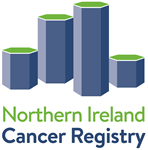Statistics
Statistics FAQ
-
How is the quality of the cancer registration data assessed?
The quality and completeness of data in the N. Ireland Cancer Registry (NICR) is regularly assessed and compared to other registries within the UK and Ireland. A useful indication of complete registration is a low dependence on death certificate records to record cancers. Less than 1% of our cancer registrations were from death certificates in 2013. Independent case ascertainment studies have estimated completeness of the NICR to be in excess of 97% for more information please click here.
-
Why are data for non-melanoma skin cancer sometimes excluded?
Non-melanoma skin cancer (NMSC, ICD-10 C44) is the most common Cancer; it is rarely fatal. Multiple NMSC tumours may occur in one individual. Many cancer registries do not collect data on all cases. However, the N. Ireland Cancer Registry collects data on all NMSC diagnosed pathologically. Because cancer registries across the world have different practices for recording NMSC (some do not record them at all), the category "all cancers combined" often omits these tumours in the interest of making international comparisons of cancer incidence more valid.
-
Why does the data sometimes change over time?
Cancer registrations may come to light many months or even years after diagnosis and the cancer registration database is continually being updated. The data presented on our website or in our publications may therefore, particularly for recent years, differ slightly from other published data relating to the same time period. Hence the statistics we publish are updated annually.
-
Does the NICR investigate claims of cancer clusters in certain areas?
Yes, we regularly investigate alleged cancer clusters. For information please click here.
-
How do the rates of cancer in Northern Ireland compare with the rest of the UK and Ireland?
Information on this area is available in the Cancer Atlas and Cancer Atlas of Ireland available from the Office of National Statistics (ONS).
-
Why is the Cancer Registry data a few years behind?
Registries do not collect data in real time, as ascertainment of all incident cancer cases and validating of all data items takes time. Cancer cases are identified through various sources such as pathology reports, scans and x-rays, and from a number of health care providers. Great care is taken to ensure accuracy of this information and also completeness of ascertainment. In order to achieve both there is however a trade-off with the timeliness of reporting data.
-
What is the latest year of complete cancer registration data?
The N. Ireland Cancer Registry has complete incidence data for 1993 to 2018 and mortality data for 1993 to 2018. Survival data is available for comparison for 1993-1998, 1999-2003, 2004-2008 and 2009-2016. Incidence data for 2018 is available for download.
-
What is the percentage of total?
The percentage of total figure indicates what proportion of the total cancers incidence / mortality in a given area the current cancer accounts for.
-
What is the crude rate?
The crude rate is the number of cases or deaths divided by the population at risk, expressed per 100,000 persons per year.
-
What is an age-specific rate?
The age specific rate is the number of cases per person in a particular age class, usually for five year age classes up to 85, expressed per 100,000 persons per year.
-
What is an age-standardised rate?
An age-standarised rate is a weighted sum of the age-specific rates which indicates the overall rate for a particular cancer. The two most commonly used age-specific rates are the European Age-Standardised Rate and the World Age-Standardised Rate.
-
What is the European age-standardised rate (EASR)?
This is the rate that would have been found if the population of Ireland had the same age-composition (proportion of total population in each five year age class) as a hypothetical European population, known as the European Standard Population (ESP). The ESP used in the Cancer Registry is that which was introduced in 2013.
The rates are calculated by applying the age-specific rates for the location being studied to a theoretical European standard population, usually expressed per 100,000 persons per year. Until 2015, a 1976 European age-standardised rate was used as some users may still depend on this data for comparison purposes. We have presented it for incidence rates in 2013.
-
What is the world age-standardised rate (WASR)?
This is the rate that would have been found if the population of Ireland had the same age-composition (proportion of total population in each five year age class) as a hypothetical world-wide population.
The rates are calculated by applying the age-specific rates for the location being studied to a theoretical world-wide standard population, usually expressed per 100,000 persons per year.
-
Which rate should I use?
The rate you should use depends on the purpose to which you propose to put the data. The European Age-Standardised Rate is a good metric by which to compare rates across Europe, and likewise the World Age-Standardised Rates is useful for comparing rates with countries outside Europe, such as the U.S.

